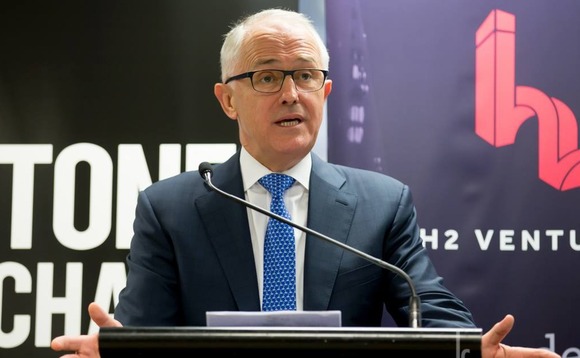
Australia VC: Policy power

Australia’s innovation agenda is intended to serve as the foundation stone of a technology-driven economy. Do the promises made to start-ups address areas where they want to see change?
In his first major policy address since being appointed prime minister of Australia, Malcolm Turnbull reaffirmed his commitment to innovation. He had also prepared an appropriate soundbite: "Unlike the mining boom, it's a boom that can continue forever."
Turnbull's words were followed by the launch of the National Innovation & Science Agenda towards the end of December. The document is regarded as the most comprehensive set of innovation policies that Australia has ever seen - a shot in the arm for a country that has fallen behind its peers in terms of math and science teaching, collaboration between academia and industry, and businesses taking risks.
It is likely to facilitate about A$1.1 billion ($795 million) in investment over the next four years, in part due to tax and regulatory measures designed to encourage commitments to start-ups.
Our message to the government is we need a solution that helps drive greater interest from institutional investors in later-stage venture funds - Yasser El-Ansary
"If you have a prime minister who in his very first public comments starts talking about the importance of innovation, entrepreneurship and seeding businesses to creating new growth corridors, that narrative permeates through the business sector and through to investors," says Yasser EI-Ansary, CEO of Australia Private Equity & Venture Capital Association (AVCAL). "This has played a large part in making them confident that the government is supportive of policies that help drive entrepreneurship."
While industry participants generally welcome the initiative, they see it as a starting point, not the finished article. Much rests on the government's ability to adapt its policies during the implantation phase.
Framework debate
Groups, including AVCAL, have been providing input to the government since last year on what a comprehensive policy framework to support innovation might look like. They covered a broad range of issues, including recalibrating the current tax system and making it easier for early and later-stage VC firms to raise capital.
In March 2015, these efforts began to bear fruit. First, the employee share scheme (ESS) was reformed to remove an upfront tax liability that was hampering the ability of local start-ups to retain talent. Second, the significant investor visa (SIV) program recalibrated so that 20% of the minimum A$5 million applicants must invest locally as a condition of entry now has to be deployed in VC funds.
The innovation agenda features incentives intended to drive further capital into the start-up community. Taking reference from measures introduced in the UK, the government said that early-stage investors can claim a 20% non-refundable tax offset based on the amount committed to a start-up or a VC fund, capped at A$200,000 per investor, per year. Capital gains generated on the disposal of these investments will generally be tax exempt.
In addition to that, the government has loosened eligibility requirements for participation in existing early stage and venture capital limited partnership (ES/VCLP) structures. For example, foreign fund-of-funds can hold more than 30% of an ES/VCLP, while trust companies are now allowed to invest as well. GPs can also raise more money, with the maximum fund size rising from A$100 million to A$200 million. All investors will qualify for a 10% tax offset on capital invested.
More importantly, an ES/VCLP will no longer have to divest a portfolio company once its total assets exceed A$250 million - the threshold above which flow-through tax treatment no longer applies. "This was requested by a group of VC investors; we are happy becoming liable for taxation when a company reaches that asset value, but we don't necessary want to sell our investment out of the scheme," says Rick Baker, co-founder of Blackbird Ventures. "Now they have changed that. It's really about making sure that the ES/VCLP program runs smoothly."
He adds that the overall tax incentives could open up a flood of capital from angel investors in Australia. These individuals have increased their commitments in recent years but more recently the pace of investment has slowed due to uncertainty - about the performance of investee companies and the growth prospects of the industry. However, the recent public market slowdown has led to an easing of valuations on the private market side, so investors might be persuaded to return.
"The later-stage private market has been hit hard, and valuations are starting to come down. It's probably a good time to provide these tax incentives now the market is suffering a little bit. You don't want to provide a lot of tax incentives when the market is really booming," says Baker.
Later-stage gap
While there is sufficient early-stage capital - predominately seed and Series A rounds - available in the system, Australia still lacks Series B and C investors. A recent AVCAL report identified an "urgent need" to address the gap between seed and later stage, with only 23%, or A$85 million, of total VC funding dedicated to bigger start-ups. It wants GPs to be able to tap domestic sources of capital in greater depth, but there are taxation obstacles.
Returns on investments made by certain classes of investor, such as superannuation funds, are taxed under the capital account and treated as a capital gain. For other investors, notably family offices and high net worth individuals, returns might be treated as income, which means a higher tax levy. AVCAL advocates adopting the Board of Taxation's 2011 recommendation to provide capital gains tax treatment for all domestic investors in VCLP programs, which currently only target foreign investors.
"What happens at the moment is a subset of domestic investors are given a particular tax outcome while another subset gets a different outcome," says EI-Ansary. "There is an immediate and long-running disconnect in the tax system that draws a distinction between different classes of domestic investors. Our message to the government is we need a solution that helps drive greater interest from institutional investors in later-stage venture funds."
However, some VC investors say this is putting the chicken before the egg. They want to see more policies encouraging entrepreneurs to come up with ideas. The innovation agenda includes measures aimed at reducing risk-aversion in the start-up community. Bankruptcy legislation changes mean that founders in a failed venture will only have to wait one year, instead of three, before creating a new start-up. There are also subsidy programs aimed at companies founded in global technology hubs.
"I don't think it is the government's job to fill the later-stage funding gap. What it should do is to ensure the current platforms in Australia can produce exciting start-ups. They have to focus on what the barriers are to producing these companies. Investors will put more money into the system if they can get good returns from early-stage investments," says Craig Blair, co-founder of AirTree Ventures.
Having said that, it makes sense for the government to target industries that face particularly steep development barriers. For example, the costs of commercialization for a biotech company are usually far higher than for counterparts elsewhere in the tech sector, and the commercialization process itself takes longer. The innovation agenda announced the A$200m CSIRO Innovation Fund, which will co-invest in spin-offs and start-ups from Australian research institutions, while the A$250 million Biomedical Translation Fund will invest alongside biomedical-focused GPs in certain deals.
They do not represent Australia's first attempt at co-investment funds. In 1997, the Innovation Investment Fund (IIF) was created to invest in start-ups backed by licensed fund managers, matching capital provided by private sector LPs. The program was discontinued in the 2014-2015 budget. Michelle Deaker, CEO of OneVentures, a former IIF recipient, says the government is not simply retracing its former steps.
"If anything, the funding has returned in a more targeted fashion," she explains. "The Biomedical Translation Fund will likely leverage the IIF program infrastructure but it exists to address the VC funding gap in terms of getting biomedical companies commercialized and incentivizing investors around this."
Confidence booster
The innovation agenda is still under consultation and is expected to come into effect from July. Investors are currently holding back, wary of changes post-consultation, but the government insists that "this is not a one-off statement." Indeed, it has indicated a willingness to modify policies over time if existing approaches are not delivering the desired outcome.
Some see this as a means of encouraging large institutional investors to participate in venture capital. With this in mind, Blue Sky Venture Capital and Square Peg Capital both recently launched A$200 million funds aimed at LPs that write bigger checks.
"We still focus on late-stage venture capital and it will be our first institution-focused VC fund," says Elaine Stead, investment director at Blue Sky. "We see a lot of smaller companies coming through the pipeline in Australia as a result of policy support over the last decade. Now they need a large quantum of capital, so we need a larger fund in order to capture that."
First State Super has already started investing more heavily in venture capital. After backing domestic funds launched by Blackbird and Brandon Capital - both of which offer co-investment opportunities to meet the needs of larger LPs - it now plans to deploy A$250m into financial technology companies managed by H2 Ventures, in line with the government announcing the Agenda.
"The government's goal is that, in five years' time, Australia will have seen a significant reset of its economy around several key areas, such as financial technology, agriculture technology and biotech," says Ben Heap, founding partner of H2 Ventures. "Collaborating with the industry is a smart way of tackling this; it's a good first step."
Latest News
Asian GPs slow implementation of ESG policies - survey
Asia-based private equity firms are assigning more dedicated resources to environment, social, and governance (ESG) programmes, but policy changes have slowed in the past 12 months, in part due to concerns raised internally and by LPs, according to a...
Singapore fintech start-up LXA gets $10m seed round
New Enterprise Associates (NEA) has led a USD 10m seed round for Singapore’s LXA, a financial technology start-up launched by a former Asia senior executive at The Blackstone Group.
India's InCred announces $60m round, claims unicorn status
Indian non-bank lender InCred Financial Services said it has received INR 5bn (USD 60m) at a valuation of at least USD 1bn from unnamed investors including “a global private equity fund.”
Insight leads $50m round for Australia's Roller
Insight Partners has led a USD 50m round for Australia’s Roller, a venue management software provider specializing in family fun parks.







